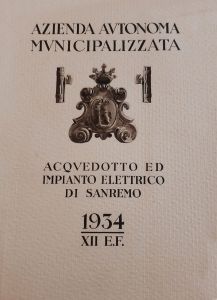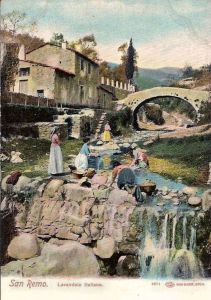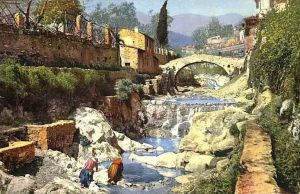In 1910 the Marsaglia aqueduct was municipalised, as mentioned above, and the Azienda Autonoma Municipalizzata per l'Acquedotto e l'energia Elettrica (AAMAIE) was created.
At the same time, two hydroelectric groups were put into operation, using the water for this purpose. But once again one of the city's main issues was dissolved for the exclusive benefit of the foreign colony and the wealthy San Remo residents.
But once again one of the city's main issues was dissolved for the exclusive benefit of the foreign colony and the wealthy San Remo residents.
This was the case for many urban planning and hygiene problems, which had been solved in the tourist districts and in the new city business centre, but had been left unresolved in the old districts where the immigrants and the lower classes of the local population were concentrated.  This was the case with the problem of drinking water, the distribution of which was organised for the exclusive benefit of guests and the rich indigenous bourgeoisie.
This was the case with the problem of drinking water, the distribution of which was organised for the exclusive benefit of guests and the rich indigenous bourgeoisie.
The fact is that subscribers who were supplied with water had to pay such high tariffs that the people of San Remo continued to draw water from public sources and store it in jars throughout that period, without having any direct connection in their homes. It was true that, between 1870 and 1900, both the number of fountains and the cubic metres of water dispensed from them had tripled, but it was also true that the population of the town had doubled during this period.
The effective litre/inhabitant ratio had therefore only slightly improved, and the inconvenience to which the people of Sanremo were subjected had only slightly reduced.
It was certainly not much, and the well system was slow to disappear. On the contrary, the quantity of water consumed by the privileged subscribers reached the then unbelievable levels of a thousand litres a day. But the wealthy lived in villas surrounded by large gardens that needed watering and they had by then all applied in their homes the latest innovation produced by the hydraulic-sanitary knowledge of the time, the water-closet, which "wasted" dozens of litres of water per day per family for flushing the latrines.
On the contrary, the quantity of water consumed by the privileged subscribers reached the then unbelievable levels of a thousand litres a day. But the wealthy lived in villas surrounded by large gardens that needed watering and they had by then all applied in their homes the latest innovation produced by the hydraulic-sanitary knowledge of the time, the water-closet, which "wasted" dozens of litres of water per day per family for flushing the latrines.
It was because of these very high levels of consumption that, despite the low number of subscriptions, what seemed to be an inexhaustible supply of water in 1885 soon became insufficient, even though from the year the system began operating, new springs were gradually introduced to increase the water supply.
Before starting the construction of the pipeline, the Marsaglia company, and previously the Société Lyonnaise des Eaux et d'Éclairage, had calculated the city's daily water requirements using the French system, which had also been applied in Nice, and had thus come to the conclusion that the 4,000 cubic metres of water from the Argallo would be largely sufficient for the city's needs and that the 3,500 cubic metres from the Ossentina would be able to cope with the new demands that the increase in population would bring.
According to this system, average consumption was calculated as 20 litres per day per person, 5 litres per worker, 5 litres per school, college or boarding school pupil and 10 litres per soldier, 60 litres per horse, 40 litres per cow, 60 litres per four-wheeled car, 40 litres per two-wheeled car, 3 litres per square metre of flowerbeds and gardens and 150 litres per day for warehouses and shops. But these parameters, which in the 1980s were considered serious, ten years later seemed inadequate for calculating the water requirements of a centre of the size and prestige of Sanremo. And if the situation was not as disastrous as these figures would suggest, it was due to the fact that the pipeline served only a limited number of San Remo residents, in addition to their wealthy guests, of course.
The actual amount of water available to the majority of citizens and the inconveniences that most of them had to face in order to procure their daily water needs were not of much interest to the administrators. The objectives they had set themselves, and which they considered important for the future of San Remo, were to provide tourists with plenty of water and to improve the hygienic conditions of the city through a consistent water supply. And these objectives were both achieved.
Needless to say, it was only from then on that flower cultivation, which required so much irrigation, was consolidated, and it is also superfluous to enumerate the immense advantages that the Aqueduct brought to the city's hygiene and to agriculture in general, apart from the particular cultivation of flowers.
Although at the beginning of the 20th century the water situation seemed to have stabilised, the continuous expansion of the city in terms of both buildings and population, until after the Second World War, increased the need to increase its water supply.
AQUEDUCTS - Municipalisation of waterworks: AAMAIE
Article Index
Page 4 of 5




